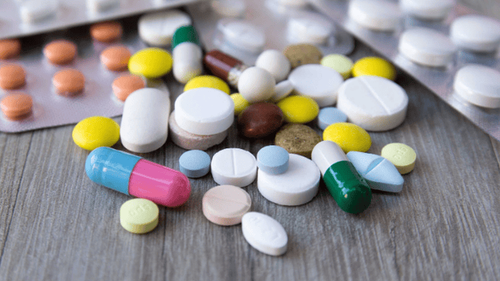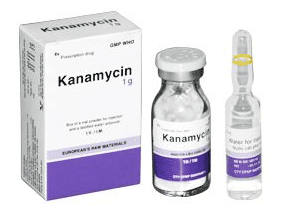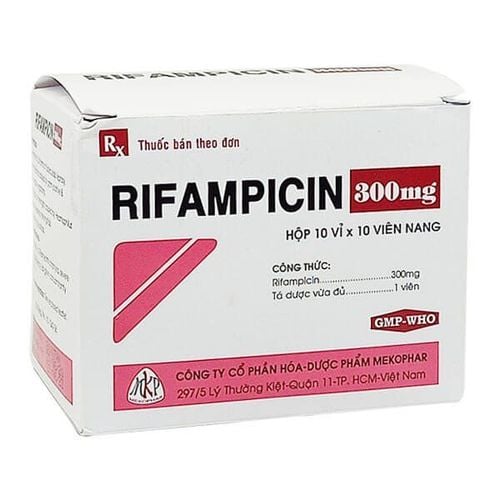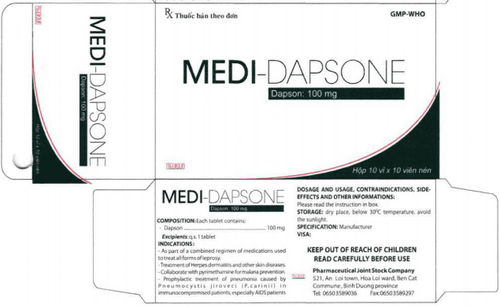This is an automatically translated article.
Rifamlife also known as rifampin, is an ansamycin antibiotic. It is used to treat certain types of infections caused by the bacteria Mycobacterium avium complex, including tuberculosis, leprosy, and Legionnaires' disease.
1. What is Rifamlife?
Rifamlife is on the World Health Organization's list of essential drugs, with the main ingredient being Rifampicin 300mg. Rifamlife is commonly indicated for use in the treatment of diseases such as:Rifampicin is used in combination with other drugs such as pyrazinamide, isoniazid and ethambutol to treat tuberculosis. Rifampicin may be used alone for patients with latent TB infection with the aim of preventing or stopping the growth of pathogenic bacteria. Rifampicin is also used in the treatment of bacterial infections including leprosy. Rifamlife is often combined with clarithromycin or other antibiotics used in the treatment of infections with Mycobacterium ulcerans. For prophylaxis against meningococcal infections Used to treat infections caused by strains of bacteria such as Listeria, Neisseria gonorrhoeae, Haemophilus influenzae and Legionella pneumophila Rifampicin is used to treat primary pruritus caused by primary cholangitis. Component Rifampicin is a semi-synthetic antibiotic produced from Streptomyces mediterranei that inhibits bacterial RNA synthesis by inhibiting bacterial DNA-dependent RNA polymerase. Therefore, it has the ability to effectively kill bacteria and treat infections.
Rifamlife is equally excreted in bile and urine and has a half-life of 2.5 hours.
The drug is contraindicated in the following cases:
Do not use the drug in cases where the patient is allergic to rifampin or other rifamycins components such as rifabutin / rifaximin / rifapentine. Do not use for patients with jaundice, porphyria and severe liver failure. In case patients are being treated for drug-resistant TB, especially rifampin-resistant or multi-drug-resistant TB, rifampin should be avoided.
2. Dosage and usage
2.1. How to take Rifamlife is prepared in the form of tablets and used orally. For the best absorption of Rifampicin ingredients, patients should take the drug on an empty stomach with plenty of water. The most appropriate time to take the drug is at least one hour before a meal or two hours after a meal.
2.2. Dosage In the treatment of tuberculosis: The dose applied to adults is 2 tablets per day. For children under 1 month of age, the dose is 10mg/kg/day. Children 2 months to 7 years old use a dose of 15mg/kg/day. Children 8 years of age and older use 10mg/kg/day.
In the treatment of serious infections caused by Gram (+) and Gram (-) strains:
Children under 1 month of age use a dose of 15-20mg/kg/day divided into 2 doses. Children from 2 months of age and older and adults use a dose of 20 -30mg/kg/day, divided into 2 times. In the treatment of diseases caused by Brucella: Use a combination of Rifampicin 900 mg/day, take the drug in the morning on an empty stomach and combine with doxycycline at a dose of 200 mg/day used in the evening. Note:
Patients with renal impairment: No dosage adjustment is required for mild and moderate renal disorders. Hepatic Impairment: Use of rifampin is generally avoided in patients with a history of liver disease because of the potential for hepatotoxicity. especially in the elderly. Overdose and treatment:
Manifestations of drug overdose: Sweating, vomiting, orange urine, increased blood bilirubin levels, increased alkaline phosphatase and transaminases. Treatment: Treatment according to the symptoms encountered. Usually after 3 days of treatment these symptoms will disappear and the body will return to normal.
3. Side effects
Some undesirable reactions that patients may experience during treatment with Rifamlife include:
Possible skin reactions such as rash, redness, itching or gastrointestinal reactions such as nausea , vomiting, loss of appetite, bloating, diarrhea. More serious can have pseudomembranous colitis. Hematologic system-related reactions include: thrombocytopenia, leukopenia, eosinophilia. If the patient develops a purpura, the drug must be stopped immediately to avoid a fatal brain hemorrhage. Experiencing flu symptoms such as headache, dizziness, fever, chills, bone pain. Effects on the respiratory system: Asthma-like respiratory disorders, hypotension, acute reversible asthenia, acute tubular necrosis, cortical necrosis Rare reactions may cause menstrual disturbances in women . The most serious side effect of taking the drug is liver toxicity. Therefore, people taking the drug should regularly have liver function tests to detect possible liver damage early. Allergic reactions include rash, itching, swelling of the tongue or throat, severe dizziness, and trouble breathing.
4. Be careful when taking medicine
When starting treatment, the patient should take the drug daily, the dose as directed by the doctor should not increase or decrease the dose of the drug. The drug causes a reaction to change the color of urine, stool and tears to orange-red. When experiencing reactions such as thrombocytopenia, purpura, hemolytic anemia, severe renal failure, the patient needs to stop using the drug. Dosage adjustment is required if the patient has severe liver failure and has high blood levels of rifampicin. In the case of patients with renal failure, the duration of taking the drug can be divided accordingly, depending on the degree of moderate or severe renal impairment (as measured by the level of creatinine clearance). For pregnant women: According to reviews, the drug can be used during pregnancy because it does not cause birth defects or neonatal complications. However, research data is not enough to confirm that the drug is 100% safe. Therefore, pregnant women should consult their doctor before taking the drug. Lactation: Because rifampicin can be excreted in breast milk. Therefore, to avoid adverse side effects for the infant, mothers should avoid breastfeeding while taking the drug. If it is necessary to take medication, consult a doctor. Because the ingredient rifampin can be toxic to the liver. Therefore, patients should have baseline liver function tests (LFTs) before starting treatment. In the presence of symptoms of hepatotoxicity such as nausea, vomiting, abdominal pain, and itching, the dose should be reduced, or rifampi should be discontinued altogether.
5. Drug interactions
Should not be used together with Rifamlife with progesterone and estrogen progesterone contraceptives, it will affect the effectiveness of the drug. Therefore, the patient should use another suitable method of contraception. Anticoagulants: Caution should be exercised when combining oral anticoagulants because they may reduce the drug's effect. Specifically: If a patient is on long-term anticoagulation with warfarin, the dose of warfarin must be increased and the clotting time checked frequently because drug interactions can lead to decreased coagulation efficiency, leading to serious consequences. serious is thromboembolism. With ciclosporin: The drug reduces the concentration and activity of ciclosporin. With corticosteroids: Rifamlife will reduce the effectiveness of corticosteroids, especially in patients with Addison Hydroxy quinidine and quinidine: Drugs that reduce plasma quinidine concentrations and the antiarrhythmic effect of Ketaconazole: When co-administered with Rifamlife, interactions The drug will reduce the effectiveness of both drugs due to enzyme induction. In case it is necessary to take these 2 drugs together, patients should take at least 12 hours apart. Alprenolol, Metoprolol, Propranolol: Note that when combined with Rifamlife, it will reduce beta-blocker concentrations and reduce the effects of drugs such as: HIV protease inhibitors, anticonvulsants (itraconazole and ketoconazole), cyclosporin, DHP CCB, sulfonylurea: Increased side effects. Acamprosate: Excretion of Acamprosate may be reduced when combined with Rifampicin. Acebutolol: The metabolism of Acebutolol may be increased when combined with Rifampicin Acetaminophen: Rifampicin may increase the hepatotoxic activity of Acetaminophen Acetohexamide: The serum concentration of Acetohexamide may decrease when it is combined with Rifampicin Almasilate: Almasilate may decrease the absorption of Rifampicin resulting in decreased serum concentrations and potentially decreased efficacy. Aluminum phosphate: Aluminum phosphate may cause reduced absorption of rifampicin leading to decreased serum concentrations and potentially decreased efficacy. 4-Aminosalicylic acid, which is an anti-tuberculosis drug: Concomitant use with Rifamlife reduces the absorption of rifampicin. If these two drugs are used at the same time, the patient must separate the time of taking the drug from the interval between doses of 8 to 12 hours.
Please dial HOTLINE for more information or register for an appointment HERE. Download MyVinmec app to make appointments faster and to manage your bookings easily.













